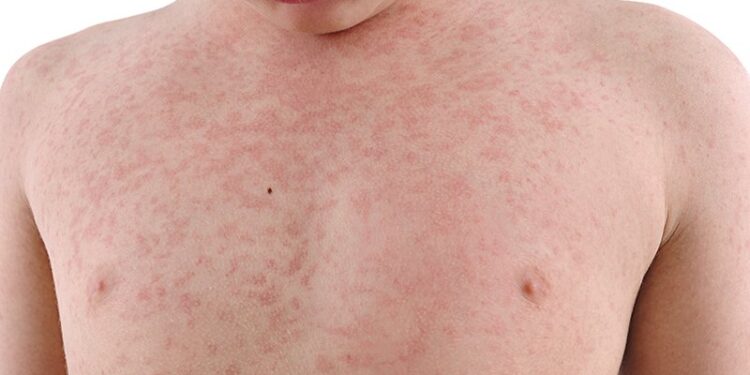Introduction
Skin lesions refer to any abnormality or change in the skin’s appearance or texture. They can range from harmless moles to severe conditions like skin cancer. Prompt diagnosis and treatment are crucial in managing skin lesions.
Types of Skin Lesions: Identifying and Differentiating Between Common Lesions
The skin is the body’s largest organ and is susceptible to various lesions. Skin lesions can arise from genetics, environmental factors, infections, and aging. Identifying and differentiating between common types of skin lesions is essential to determine the appropriate treatment.
There are many skin lesions, but the most common ones include moles, warts, cysts, and rashes. Moles are pigmented growths that can be flat or raised, while warts are small growths caused by the human papillomavirus. Cysts are sac-like structures under the skin that contain fluid, while rashes are inflamed, discolored, or swollen areas of skin.
Differentiating between these lesions can be challenging, but there are a few key differences to look out for. For example, moles tend to be evenly colored and have a defined edge, while warts may have tiny black dots and an irregular shape. Cysts are typically painless and soft, while rashes may be itchy and inflamed.
If you are unsure about a skin lesion, it is essential to consult with a dermatologist who can perform a thorough evaluation and provide appropriate treatment.
Causes of Skin Lesions: Understanding the Factors that Contribute to Lesion Development
Skin lesions can arise from various causes, including genetics, environmental factors, infections, and even aging. Understanding the factors contributing to developing skin lesions is essential to help prevent their occurrence.
One of the most common causes of skin lesions is exposure to the sun’s harmful UV rays. Prolonged exposure to the sun can cause damage to the skin cells, leading to the development of moles and even skin cancer. Other environmental factors like pollution and exposure to certain chemicals can also contribute to the development of skin lesions.
Genetics can also play a role in the development of skin lesions. Specific genetic mutations can increase the risk of developing certain types of skin lesions like moles and cysts. Infections like the human papillomavirus (HPV) can cause the development of warts, while viral infections like herpes can cause the development of painful blisters.
In some cases, skin lesions can also arise due to underlying medical conditions like eczema, psoriasis, and even diabetes. These conditions can cause changes to the skin’s appearance and texture, leading to the development of lesions.
It is essential to prevent skin lesions by protecting the skin from harmful UV rays, avoiding exposure to chemicals and pollutants, and maintaining a healthy lifestyle. If you notice any unusual changes to your skin, it is essential to consult with a dermatologist to rule out any underlying medical conditions and receive appropriate treatment.
Diagnosing Skin Lesions: Examining the Process and Tools Used to Identify Lesions
Diagnosing skin lesions requires a thorough examination by a dermatologist, who can determine the cause of the lesion and provide appropriate treatment. The diagnostic process involves a combination of visual inspection and medical tools.
During a visual inspection, the dermatologist will examine the lesion’s appearance and location on the skin. They may use a magnifying glass or a dermatoscopy to get a closer look at the lesion’s characteristics, like its shape, colour, and texture. The dermatologist may also ask questions about the lesion’s history, such as when it first appeared and whether it has changed.
Medical tools like a biopsy may be used to confirm a diagnosis. A small lesion sample is removed during a biopsy and sent to a laboratory for analysis. The biopsy results can help determine if the lesion is cancerous or benign.
In some cases, imaging tests like a CT scan or MRI may be ordered to get a better look at the lesion’s location and size. These tests can also help determine if the lesion has spread to other body areas.
Overall, the diagnostic process for skin lesions is individualized based on the type and location of the lesion. Consulting with a dermatologist is essential for an accurate diagnosis and appropriate treatment. Early diagnosis and treatment are crucial in managing skin lesions and preventing complications.
Treatment Options for Skin Lesions: Exploring Medical and Non-Medical Approaches for Managing Lesions
Treatment options for skin lesions depend on the lesion’s type, size, and location. There are several medical and non-medical approaches available for managing skin lesions.
Medical treatments for skin lesions include:
- Surgical removal.
- Cryotherapy (freezing the lesion with liquid nitrogen).
- Laser therapy.
- Medications like topical creams or oral antibiotics.
Surgical removal is often recommended for cancerous or pre-cancerous lesions, while cryotherapy and laser therapy may be used for non-cancerous lesions like warts or moles. Topical creams and oral antibiotics may treat infections that cause skin lesions.
Non-medical approaches for managing skin lesions include home remedies and lifestyle changes. For example, applying tea tree oil or apple cider vinegar to a wart may help it disappear over time. Wearing sunscreen and protective clothing can also help prevent the development of new lesions caused by sun damage.
In some cases, medical and non-medical approaches may be used to manage skin lesions. For example, surgical removal of a cancerous lesion may be followed by lifestyle changes like wearing sunscreen and protective clothing to prevent the development of new lesions.
It is essential to consult with a dermatologist to determine the best treatment approach for your specific skin lesion. Early diagnosis and treatment are crucial in managing skin lesions and preventing complications like infection or cancer. Many skin lesions can be successfully managed and even eliminated with proper treatment.
Also, Read: 5 Effective Lower Back Stretches to Alleviate Pain and Improve Flexibility











Discussion about this post